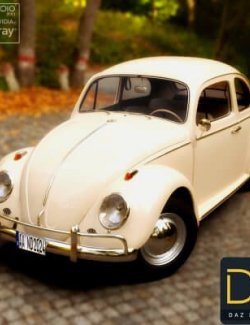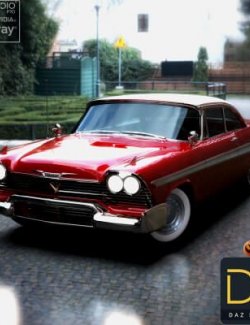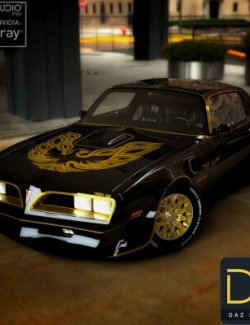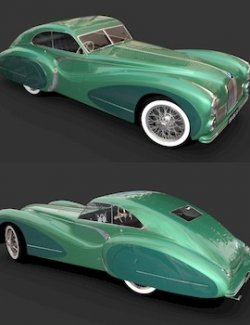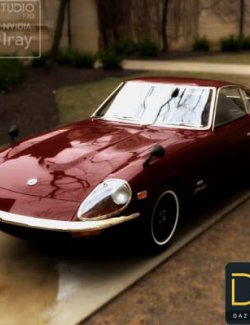Click on image to see gallery.
Warning! Some images may contain nudity and are not suitable for all viewers.
Opel GT 1968 for DAZ Studio preview image 0Opel GT 1968 for DAZ Studio preview image 1Opel GT 1968 for DAZ Studio preview image 2Opel GT 1968 for DAZ Studio preview image 3Opel GT 1968 for DAZ Studio preview image 4The Opel GT is a front-engine, rear-drive two-seat sports car manufactured and marketed by Opel in two generations separated by a 34-year hiatus.
The first generation Opel GT (1968–1973) debuted as a styling exercise in 1965 at the Paris and Frankfurt motor shows.The production vehicle used mechanical components from the contemporary Opel Kadett B and two-door hard top bodywork by French contractor Brissonneau & Lotz. The styling of the GT was often cited as similar to the 1968 Chevrolet Corvette which went on sale in September 1967.
Opel marketed a second generation GT (2007–2009) as a rebadged variant of the Saturn Sky two-seater convertible (which was based on the Pontiac Solstice), manufactured in Wilmington, Delaware, USA.
In 2016, Opel introduced the GT Concept at the 2016 Geneva Motor Show as a lightweight, turbocharged, rear-wheel drive two-seater.
The Opel GT was equipped with a base 1.1 L OHV inline-four engine, which produced 67 hp (SAE) at 6,000 rpm. However, most buyers chose an optional 1.9 L camshaft in head engine, which produced 102 hp (SAE) at 5200 to 5400 rpm. Some of the early 1968 models also came with a slightly higher compression "H" code cylinder head. In 1971, due to emissions regulations, Opel reduced the compression ratio of the 1.9 L engine used in the US and output fell to 83 hp (SAE). There was also a GT/J model, which was a less expensive version of the 1.9 L GT that lacked nearly all chrome parts and offered fewer standard features, sold only in Europe. The base transmission was a four-speed manual. A three-speed automatic was available with the 1.9 L engine. The model run of the Opel GT was from 1968 to 1973.
The Opel GT has a steel unibody chassis and a front mid-engined, rear-wheel drive layout. The engine is mounted far back in the chassis to improve weight distribution. Front suspension consists of upper A-arms and a lower transverse leaf spring. A live axle and coil springs are used in the rear. The power-assisted braking system uses disks in the front, drums in the rear. Steering is unassisted.
One unusual feature of the Opel GT is the operation of the Hidden headlamps. They are manually operated, by way of a large lever along the center console next to the shifter. Unlike pop-up headlights, they both rotate in the same direction (counterclockwise from inside the car) about a longitudinal axis.
Designed by Opel stylist Erhard Schnell, the GT is a fastback, that has neither an externally accessible trunk nor a conventional hatchback. There is a parcel shelf behind the seats that can only be accessed through the main doors. Behind the parcel shelf is a fold-up panel that conceals a spare tire and jack.
During 1968 to 1973, a total of 103,463 were sold — including the first few hundred cars hand-assembled in 1968 and the 1968–1970 models with the 1.1 L engine, which totaled 3,573 cars. Of the later GTs, 10,760 were the cheaper model GT/J model. In some markets, items like a limited slip differential, front and rear anti-sway bars, heated rear window, and engine bay light were standard, although most cars were shipped without them.
In North America, the GT was marketed at Buick dealerships.There was, unusually, no Vauxhall counterpart to the GT for the United Kingdom.
Reasons for ending production were the need to redesign the car to remain competitive with up-and-coming sports models, such as the Datsun 240Z, as well as the termination of Brissonneau and Lotz' bodybuilding contract.
The Opel GT was also used by Italian coachbuilder Sergio Coggiola to create the Opel Sylvia GT, an angular design of the folded-paper school. The 1973 Sylvia was also designed with an eye to safety.
Automotive magazine Road & Track reviewed the GT in their June 1969 issue, recording 0–96 km/h in 10.8 seconds and a top speed of 182 km/h. Road & Track also found the car to have strong understeer, suggesting the 165x13 tires to be too small, although the ride was comfortable.
The 1968 Opel Coupé could not deny a certain similarity to the legendary 1968 American Corvette, nor did it want to. It followed a new design style called the "Coke Bottle Shape", which also outstanding the Stingray. "Besides having a fantastic look, the Opel sports car was primarily designed to impress with sophisticated aerodynamics," explains Erhard Schnell, GT designer at the time. A sleek front end with retractable headlamps that rotate on the longitudinal axis, broad fender, tapered flanks in the door area, then bulky rear fenders which flow into the rear with sharp separating edges and round lamps - these were the Opel GT's key design characteristics.
"Safety belts are standard, please buckle up" - this was the Opel advertisement that promised GT occupants outstanding acceleration. And the driving performance the sporty 90 hp two-seater offered was truly top class in the late 1960s. Its 1.9-liter engine accelerated the GT from zero to 100 km/h in 10.8 seconds, and on to a top speed of 185 km/h. Almost 40 years ago, this was really fast. As a top model in the upper mid-class segment at that time, the Opel Rekord 1.9 had a top speed of 160 km/h, for example. The 200 km/h threshold was like the sound barrier, and had just been crossed by the muscle cars of that generation, such as the Mercedes 280 SE 3.5 with a 200 hp V8 engine. A Porsche 912 - which was commonly considered to be a car in the shape of the first 911, with four cylinders and 90hp, just like the Opel GT - also had a top speed of 185 km/h, but took 12.5 seconds from zero to 100 km/h.
The 1968 GT's sporty handling matched its performance figures thanks to a chassis with front twin A-arm axle and rear center-joint rigid axle with bolted springs, longitudinal control arm and lateral track bar.
Did you know that…?
from 1968 to 1973, exactly 103,464 units of the GT were produced? The GT is a permanent collectors highlight, and a well-maintained model can fetch a fortune.
85 percent of the entire GT production run was exported, and 70,222 units (around 70 percent) went to the USA alone?
the GT's body in white was created by French specialists Chausson (Reims), while Brisonneau & Lotz in Creil, north of Paris, took care of lacquering, electrics and interior equipment? The final car assembly took place in Bochum, where the body was 'married' to the powertrain and chassis. It was also the production center for the Kadett, upon which the GT was based.
space for the 1.9-liter engine, which was also used in the Rekord, was so small that the hood had to be power domed and the cylinder-head cover skewed in the front section? The "Power dome" was not just for show!
the Aero GT concept with removable targa roof was presented in 1969 at the IAA? One of the two prototypes can be found today in Opel's classic collection.
the company founder's grandson, Georg von Opel, reached 188 km/h in mid-1971 at Hockenheim in a converted Opel GT with electric propulsion? The following year, a team of motoring journalists and race car drivers set 20 world records at the Opel Test Center in Dudenhofen in the "Diesel World Record GT 1972".
many reasons led to the end of production in August 1973? These included demands from the USA - the most important export market - to fit bulky safety bumpers, which did not match the style of the car, and the fact that Brisonneau & Lotz was bought by Renault, signaling the end of the contractual relationship with Opel.
Robert A. Lutz, "car guy", GM Vice Chairman, Global Product Development, was a sort of godfather to both Opel GTs? In 1968, in his position as Manager at Opel, he played a decisive role in speeding up the decision on series production, and he also gave the green light to the new General Motors roadster troop
------------
System Requirements:
PC / MAC 0SX
Product Requirements:
Daz Studio
------------
Ownership Statement:
All of this product's content was created by SamGrey
------------
Installation Instructions:
Open the zip file in WinZip
Click EXTRACT
Verify that ALL FILES is checked
Verify that USE FOLDER NAMES is checked
Extract the folder to C:\Daz 3D\Applications\Data\DAZ 3D\My DAZ 3D Library
==========
DAZ
This pack for Daz Studio contains a Opel GT 1968 with lights and textures included.
Let your imagination run wild and create wonderful scenarios with this stuff.
Have Fun!!
Mesh data
vertices: 149.317
triangulos:197.163
Where to buy: RenderHub
Publish date: August 25, 2024








